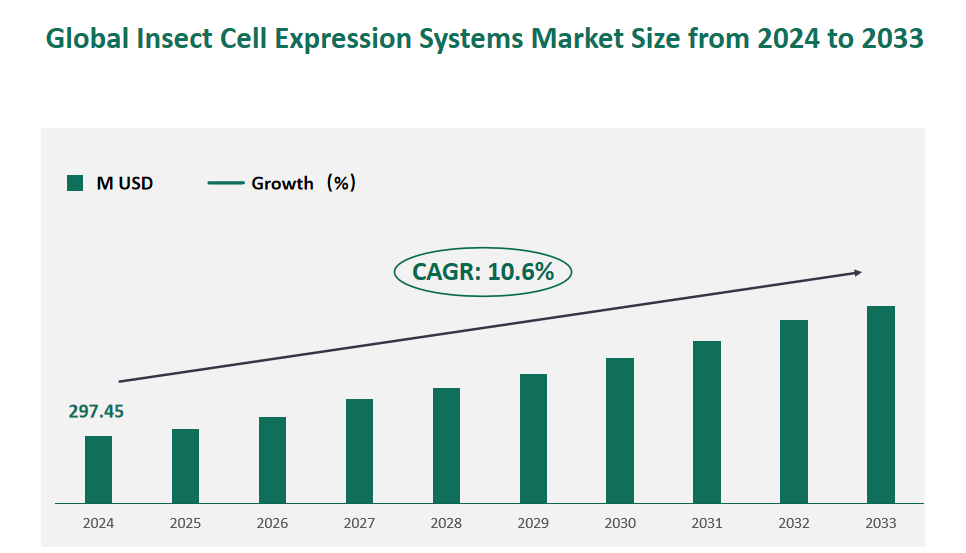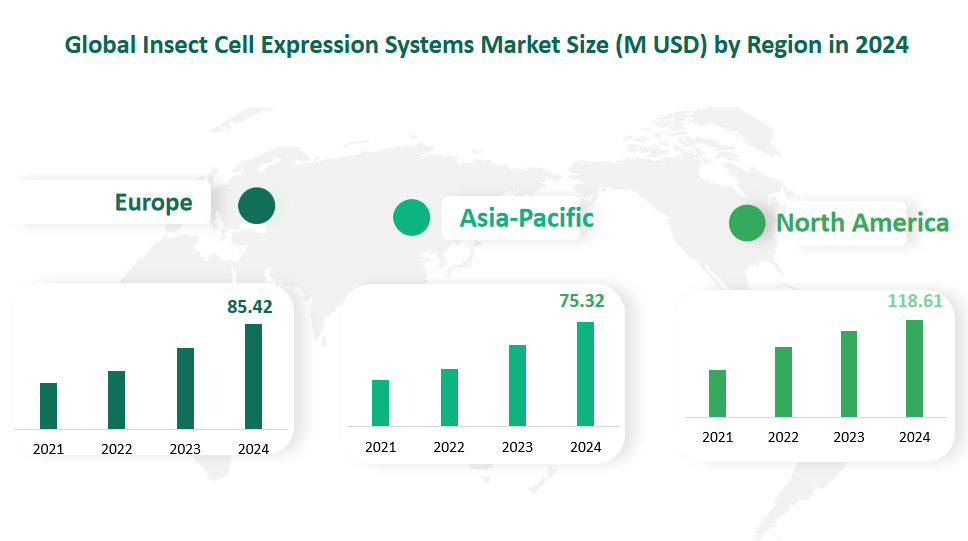1 Global Insect Cell Expression Systems Market Size (Value) and CAGR (2024-2033)
In 2024, the global Insect Cell Expression Systems market value is forecasted to reach 297.45 million USD, with a CAGR of 10.6% from 2024 to 2033.
Insect Cell Expression Systems are powerful and versatile platforms designed for the production of high levels of recombinant protein expression in insect cells. These systems harness the capabilities of insect cells, which offer post-translational modifications similar to those of mammalian cells, ease of scale-up, and simplified cell growth that can be adapted to high-density suspension culture for large-scale expression.
Figure Global Insect Cell Expression Systems Market Size (M USD) and CAGR 2024-2033

2 Insect Cell Expression Systems Market Drivers and Trends
The Insect Cell Expression Systems (IC-BEVS) market is experiencing transformative trends and growth drivers that are shaping its future trajectory. One of the key development trends is the increasing application of IC-BEVS in the production of biopharmaceuticals, particularly in the realms of vaccine development and therapeutic protein production. The system’s ability to yield high levels of recombinant protein expression with post-translational modifications similar to mammalian cells makes it an attractive choice for complex protein production.
Another significant trend is the technological advancement in baculovirus-insect cell expression systems, which allows for the production of multi-subunit protein complexes and virus-like particles. This capability is particularly beneficial for studying the structure and function of proteins, and it has been instrumental in the development of vaccines for diseases such as polio, bluetongue virus, and COVID-19.
The driving factors behind the growth of the IC-BEVS market include the rapid development of life sciences and the increasing demand for cell engineering in bioengineering technology. The advantages of IC-BEVS, such as high expression levels, large gene capacity, and sufficient post-translation modification, make it a preferred choice for commercial-scale production. Additionally, the system’s high biological safety, as insect baculoviruses have a narrow host range and are non-pathogenic to mammals, adds to its appeal.
The application of IC-BEVS in various fields, including human and animal vaccines, antibody research and development, and therapeutic drug production, is another driving factor. The success of vaccines like Cervarix and FluBlok, which were produced using insect cell technology, underscores the market’s potential. The growing investment in research and development, coupled with the need for innovative solutions in drug discovery and vaccine development, is expected to further propel market growth.
3 Insect Cell Expression Systems Market Challenges and Restraints
Despite the promising outlook, the Insect Cell Expression Systems market faces several challenges and restraints. One of the primary challenges is the risk of technological upgrade iteration. The industry is knowledge and technology-intensive, requiring constant updates and iterations to keep pace with new discoveries and technologies. This rapid technological evolution can be a challenge for companies to adapt and maintain competitiveness.
Another challenge is the inherent defects of IC-BEVS, such as the late-stage activity of the P10 promoter, which can limit protein expression. Additionally, the complex N-glycan structure produced by insect cells can alter the stability and biological activity of recombinant proteins, impacting vaccine immunogenicity. The difficulty in purifying the expressed antigen protein due to its mixture with a large amount of baculovirus can also hinder the system’s broader adoption.
Restraints include the protein hydrolysis problem, where the lytic nature of BEVS and the expression of proteases can lead to recombinant protein degradation. Strategies to control this include vector construction with protease gene deletion and the use of early promoters to start recombinant protein expression.
4 Global Insect Cell Expression Systems Market Size by Type in 2024
The global Insect Cell Expression Systems market is segmented into four primary types: Reagents, Expression Vectors, Competent Cells, and Instruments. Each type plays a distinct role in the field of biotechnology and life sciences, contributing to the market’s diversity and growth.
Reagents: Expected to generate the highest revenue at 152.08 million USD in 2024, reagents are essential components in insect cell expression systems. They include substances like transfection reagents that facilitate the efficient transfer of genetic material into insect cells, enabling high-level protein expression. Reagents are crucial for both transient and stable transfections in serum-containing or serum-free media, making them a cornerstone in insect cell research and production.
Expression Vectors: With a projected revenue of 86.76 million USD for 2024, expression vectors are plasmids or viruses engineered for gene expression within cells. These vectors introduce specific genes into target cells, leveraging the cell’s protein synthesis machinery to produce the encoded protein. In the context of insect cell expression systems, expression vectors are designed to achieve rapid and high-level protein expression, eliminating the need to create recombinant baculoviruses for protein expression.
Competent Cells: Forecasted to revenue at 39.58 million USD in 2024, competent cells are those that have been treated to allow the uptake of foreign DNA. In the insect cell expression systems, these cells are prepared to receive and express the genes introduced via vectors, playing a pivotal role in the production of recombinant proteins.
Instruments: Projected to generate 19.03 million USD in 2024, instruments in this context refer to the specialized equipment used in the insect cell expression systems. This includes devices for cell culture, transfection, and protein analysis, which are essential for the efficient operation of these systems.
Table Global Insect Cell Expression Systems Market Size by Type in 2024
Type | Market Size (M USD) 2024 |
Reagents | 152.08 |
Expression Vectors | 86.76 |
Competent Cells | 39.58 |
Instruments | 19.03 |
5 Global Insect Cell Expression Systems Market Size by Application in 2024
The global Insect Cell Expression Systems market, when segmented by application, is primarily divided into three domains: Therapeutic, Industrial, and Research. Each application leverages the unique capabilities of insect cell expression systems to meet specific industry needs.
Therapeutic: With a projected revenue of 180.29 million USD in 2024, the therapeutic application segment dominates the market. This segment includes the use of insect cell expression systems in the production of therapeutic proteins and biopharmaceuticals, such as monoclonal antibodies and vaccines. The high revenue projection is attributed to the growing demand for advanced treatments and the role of insect cells in gene therapy and drug development.
Industrial: The industrial application is expected to generate a revenue of 38.1 million USD in 2024. This segment involves the large-scale production of recombinant proteins for various industrial purposes, including biopesticides, biofuels, and other biotechnological products. The industrial application benefits from the scalability and efficiency of insect cell expression systems.
Research: The research application is projected to have a revenue of 79.06 million USD in 2024. This segment encompasses the use of insect cell expression systems in academic and scientific research for understanding protein functions, disease mechanisms, and developing new biotechnological tools. The continuous growth in life sciences research fuels the demand for such systems.
Table Global Insect Cell Expression Systems Market Size by Application in 2024
Application | Market Size (M USD) 2024 |
Therapeutic | 180.29 |
Industrial | 38.10 |
Research | 79.06 |
6 Global Insect Cell Expression Systems Market Size by Region in 2024
The global Insect Cell Expression Systems market, when examined by region, reveals a diverse landscape with varying levels of market penetration and growth.
North America: With a projected revenue of 118.61 million USD in 2024, North America leads the market. This region’s dominance is due to its strong presence in the biotechnology industry, advanced research facilities, and a robust healthcare system that demands high-quality biopharmaceuticals.
Europe: Europe is expected to generate a revenue of 85.42 million USD in 2024. The region’s mature pharmaceutical industry and investment in life sciences research contribute to its significant market share.
Asia-Pacific: The Asia-Pacific region is projected to have a revenue of 75.32 million USD in 2024. The rapid growth in this region can be attributed to the increasing biotechnology sector, particularly in countries like China and India, which are focusing on expanding their biopharmaceutical capabilities.
Latin America: Latin America is expected to generate a revenue of 11.64 million USD in 2024. While the market is smaller compared to other regions, there is potential for growth due to emerging markets and increasing investments in healthcare and biotechnology.
Middle East and Africa: This region is projected to have a revenue of 6.46 million USD in 2024. The market in this region is relatively nascent but is expected to grow with improving economic conditions and investments in research and development.
Figure Global Insect Cell Expression Systems Market Size by Region in 2024

7 Major Players in Global Insect Cell Expression Systems Market
7.1 Merck KGaA
Company Profile: Merck KGaA, established in 1668 and headquartered in Germany, is a global leader in the pharmaceutical and chemicals industry. The company is renowned for its extensive research in oncology, neurodegenerative diseases, autoimmune and inflammatory diseases, and it also markets a range of products including cardiovascular, fertility, endocrinology, and over-the-counter products.
Business Overview: Merck KGaA operates on a global scale, with a strong focus on R&D to introduce new product offerings. The company has a risk-diversified business portfolio and has consistently shown strong financial performance. Merck KGaA is committed to expanding its capabilities and production, solidifying its position as a global leader in Insect Cell Expression Systems.
Product Overview: Merck KGaA offers a range of products for insect cell expression, including the InsectDirect® System for rapid protein expression, and the pIEx™ series of transient expression vectors designed for high-level protein expression in insect cells without the need for recombinant baculovirus production.
Financials (2022): In 2022, Merck KGaA reported a revenue of 50.99 M USD and a gross margin of 40.88%.
7.2 Thermo Fisher Scientific
Company Profile: Founded in 1956 and headquartered in the USA, Thermo Fisher Scientific is a worldwide leader in serving science with an annual revenue of approximately $40 billion. The company provides a comprehensive range of innovative technologies, purchasing convenience, and pharmaceutical services.
Business Overview: Thermo Fisher Scientific supports customers in accelerating life sciences research, solving complex analytical challenges, and improving patient health through diagnostics. The company is known for its unrivaled combination of technologies and services through industry-leading brands.
Product Overview: Thermo Fisher Scientific offers insect cell expression products such as the ExpiSf Expression System for superior protein yields and the Bac-to-Bac Baculovirus Expression System for high-titer recombinant baculovirus production.
Financials (2022): Thermo Fisher Scientific achieved a revenue of 39.36 M USD in 2022, with a gross margin of 49.00%.
7.3 GenScript Biotech Corporation
Company Profile: Established in 2002 and headquartered in the USA, GenScript Biotech Corporation is a leading global provider of gene synthesis services. The company has a significant presence in North America, the EU, and Asia Pacific, offering a comprehensive suite of recombinant protein and antibody services.
Business Overview: The company has a global workforce of over 5,000 employees, with 33% holding master’s and/or Ph.D. degrees, and has developed leading commercial technologies in synthetic biology and immunotherapy.
Product Overview: GenScript Biotech Corporation is committed to accelerating scientific discovery through its proprietary GenSmart™ Codon Optimization and TurboCHO™ expression platform. GenScript offers recombinant protein expression services across different expression systems, including the baculovirus/insect system. The company specializes in tailoring various challenging protein targets and offers high-throughput and large-scale services.
Financials (2022): GenScript Biotech Corporation reported a revenue of 20.46 M USD in 2022, accompanied by a gross margin of 43.17%.

